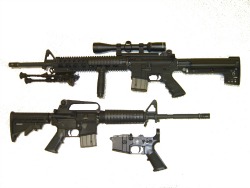 When Eugene Stoner invented the AR-15 in the 1950s, I doubt he ever imagined the rifle’s success of today. In the age where hardwood stocks and full power cartridges reigned supreme, the little “Mattel toy” rifle with plastic stock and aluminum parts looked like something from a science fiction film. First adopted by the Air Force, and then by the Military as the M-16, the rifle went on to widespread use in Vietnam. Teething problems and improvements quickly followed for the M-16 and found their way into civilian model AR-15s. This would be the case for the next 40 years.
When Eugene Stoner invented the AR-15 in the 1950s, I doubt he ever imagined the rifle’s success of today. In the age where hardwood stocks and full power cartridges reigned supreme, the little “Mattel toy” rifle with plastic stock and aluminum parts looked like something from a science fiction film. First adopted by the Air Force, and then by the Military as the M-16, the rifle went on to widespread use in Vietnam. Teething problems and improvements quickly followed for the M-16 and found their way into civilian model AR-15s. This would be the case for the next 40 years.
The AR-15 began as a semi-automatic civilian rifle started when Colt started selling the rifle in the 1960s. At first, sales were slow, prices were expensive, and problems found on service rifles were mirrored in civilian AR-15s. The AR was never a popular rifle during the 20th century for civilians. Surplus WWII firearms, cheap Chinese imported AKs and SKS rifles, and other similar, cheap guns took a huge bite out of the AR’s market. Their reputation as a problematic firearm that jammed when slightly dirty did not help either.
Related: AR-15 Magazine Management Strategies
 The 1994 Assault Weapons Ban seemed like the final nail in the pine box for the AR-15. Instead, it spurned one of the greatest quality improvements of a product in firearms history. During the ban, small companies started to improve the AR platform. At the same time, the Military adopted the M-4 Carbine. M-4 semi-automatic clones soon hit the civilian market when the ’94 AWB expired. The War on Terror and the expiration of the ’94 ban in late 2004 unleashed a flood of greatly improved tactical rifles that took the civilian market by storm.
The 1994 Assault Weapons Ban seemed like the final nail in the pine box for the AR-15. Instead, it spurned one of the greatest quality improvements of a product in firearms history. During the ban, small companies started to improve the AR platform. At the same time, the Military adopted the M-4 Carbine. M-4 semi-automatic clones soon hit the civilian market when the ’94 AWB expired. The War on Terror and the expiration of the ’94 ban in late 2004 unleashed a flood of greatly improved tactical rifles that took the civilian market by storm.
The NRA successfully brought to civilian attention that an AR-15 is not a fully automatic assault rifle, but a very accurate and utilitarian rifle. All of this coupled by an increasingly gun-friendly society spurned sales. Though the AR competed with cheap AK pattern imported rifles in the early 2000s, scores of veterans returning from the Middle East provided a loyal following for the AR-15. With the election of Barack Obama in 2008 and threats of gun bans, the popularity of the AR-15 soared.
Every Shape and Size
 With the adoption of the M4 by the US military and the sunset of AWB in ’04, almost all AR-15s are modeled after the M4 carbine. These compact AR-15s with their 16-inch civilian length barrels are built with 3 goals in mind. Accuracy. Reliability. Modularity. The modern AR-15 is the equivalent of the adult erector set. With a small set of tools and an Armorer’s wrench, a shooter can modify his rifle in his garage, or build one from scratch.
With the adoption of the M4 by the US military and the sunset of AWB in ’04, almost all AR-15s are modeled after the M4 carbine. These compact AR-15s with their 16-inch civilian length barrels are built with 3 goals in mind. Accuracy. Reliability. Modularity. The modern AR-15 is the equivalent of the adult erector set. With a small set of tools and an Armorer’s wrench, a shooter can modify his rifle in his garage, or build one from scratch.
The AR-15 outfitted with its flat top receiver can use almost any optic available to man, from traditional rifle scopes, to combat optics such as the ACOG. Quad rails allow mounting of lights, rapid transition sights, lasers, and a whole host of other accessories. I know a shooter who mounted a bottle opener on his.
You can still find full-size AR-15 rifles the same dimensions as the M-16A2/A4, or you can opt for a Carbine length rifle. A mid length rifle is the same size as the carbine length M-4, but they offer the ability to be able to correctly mount a bayonet and provides more reliability with its gas impingement system.
The AR-15 Today
 How has the AR become so popular? A huge reason was the threat of gun bans on semi-automatic rifles and what many Americans saw as a possible infringement of their 2nd Amendment rights. In 2008, one of Barack Obama’s campaign goals was a permanent version of the 1994 Assault Weapons Ban. American shooters poured into gun stores over the next 8 years and purchased millions of semi-automatic rifles that were targeted by left-leaning politicians and anti-gun groups. This repeated itself in 2012 with Obama’s reelection, after the Sandy Hook shooting and right before the 2016 Presidential election. Between 2008-2016, it was estimated more than 1 million AR-15s were produced annually for civilians in the USA. That doesn’t count parts kits and lower receivers for people to assemble their own rifles.
How has the AR become so popular? A huge reason was the threat of gun bans on semi-automatic rifles and what many Americans saw as a possible infringement of their 2nd Amendment rights. In 2008, one of Barack Obama’s campaign goals was a permanent version of the 1994 Assault Weapons Ban. American shooters poured into gun stores over the next 8 years and purchased millions of semi-automatic rifles that were targeted by left-leaning politicians and anti-gun groups. This repeated itself in 2012 with Obama’s reelection, after the Sandy Hook shooting and right before the 2016 Presidential election. Between 2008-2016, it was estimated more than 1 million AR-15s were produced annually for civilians in the USA. That doesn’t count parts kits and lower receivers for people to assemble their own rifles.
A greatly improved product with the reliability nearly equal to an AK has helped as well. In fact, torture tests have demonstrated that the AR-15 is closing the gap with the AK pattern when it comes to reliability. Longevity, however, remains with the AK, whereas an AR-15 will need some critical rebuilding after 20,000 rounds or so. Aftermarket products such as grips, stocks, sights, and internals have spurned a huge custom rifle movement.
Lastly, the increased demand starting in 2008 created an interesting problem. It forced gun makers to greatly increase production, saturating the market and causing prices to drop drastically. Prices have fallen on the AR-15. It used to cost a shooter at least $1000 for a decent AR-15 rifle. They can be had now for $400-$500. No longer is the AK the budget defensive rifle, that has now been taken over by the formerly expensive AR. In fact, a good com-bloc imported AK is now more expensive than an AR-15 from Palmetto State Armory. With a saturated market, improved quality, and a movement behind it, the AR’s time has truly, and finally arrived!
Featured Photo Courtesy of:
Sean Dobbins
All other photos included are in the public domain.

7 comments
spurred, I believe, is the word you meant to use…
sorry Zach…
my parents were older people, who were educated in a time when the language was spoken more precisely. I learned it from them. I mean no disrespect, to you. we’re from “Philly” where people shopped at the “Ac-a-mee”(ACME),
and went to the “lie-bury”(library) to do our homework. our pronunciations are as tortured as you will find anywhere, but we spelled the words right. today, people say “prolly”,
and have no clue that it’s spelled: probably.
I think your post is entirely valid, but we deplorables will be dismissed out of hand, if we can’t spell…
The “AR” rifles/carbines today have the same problems that they had in 1959. Even with the M1 Garand feed ramp geometry (renamed the M4) and the “anti tilt” magazine, they are still the same jam-o-matic they were in 1968. It is a weapon I do not trust not to fail me when I need it the most, and I will never carry another one of them. Given the choice I’d carry a 1903 Springfield , a Mauser, or a Mosin Nagant or almost ANYTHING ELSE before I would an “AR” pattern rifle. Every rifle Eugene Stoner Designed was an utter failure except one, and it became the longest running boondogal in DC history. The M16. The government has been trying to “replace” the “m16” for 50 years. But as long as the DC corruption machine keeps running the pentagon we’ll be stuck with it. Too bad that so many “preppers” will die when the gun fad in their hand fails at a critical moment like it has for generations of our military.
I completely disagree Ray. Yes I had many M4s jam on me during my time in the Guard, funny how all of that changed when I got my AR15. I believe that most of the problem with the M4s is the mags, the military think 100,000 through one magazine is a wonderful idea and forgets that mags are not supposed to last the life of the rifle. I have yet to have my AR jam on me, I don’t treat my firearms like garbage, but I know people who have put their ARs through hell and the rifle kept on going.
A lot of the complaints against the M4/AR15 actually have to do with the DC corruption you mention and not the rifle itself, the constant jams during the Vietnam because they decided to use the wrong powder for the rounds, the inadequate ballistics on flesh because the government chose a round because it could penetrate Soviet helmets at extreme distances and not because of how well it performed against flesh.
They keep trying to replace the M4 because the military likes to spend money, but none of the replacements put forward yet have been able to perform as well as an M4 with good mags. I notice you listed bolt actions as suitable alternatives to the AR, I suggest you look into the study after WW2 that lead to the creation of the AR; in which, a lot of soldiers verified that combat tended to take place at close ranges where rifles like the Garand were too heavy and overpowered.
Ray,
Your still living in the 60s concerning your opinion on the AR platform. Bolt rifle will fail you. You just fail to understand this fact, because the bolt rifles don’t have the volume of rounds put through them, thus causing you to falsely assume they don’t jam or fail. If you put 20,000 rounds through a bolt rifle like the AR it will fail at some point. I assure you that 1903 probably hasn’t even hit the 20,000 round mark even after 100 years. Even the AK jams and fails. Every machine does at some point!!!!
AR-15, the only rifle which is on top in my favorite list and this blog is really helping me to know more about rifle AR-15, So I just wanna thank the author for posting such an informative post and I’m looking forward to read more.
I thought your line about ARs not being popular in the 20th century needed further research (by me, not you), and found the same thing. I then remembered buying my first AR (an Armalite, built by a newly rebranded Eagle Arms) circa 1995 or 6 or so was something that had to be ordered through an FFL and took a couple of months to actually show up. The shop owner actually ordered 2, mine and one to put out on his shelf because he didnt have anything but a few high priced Colts and some non AR semi autos in inventory. Buying a new AR even a little over 20 years ago was kind of a rare thing.
Cool article, thanks.